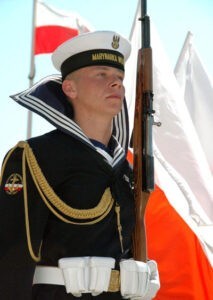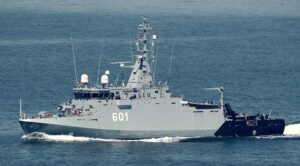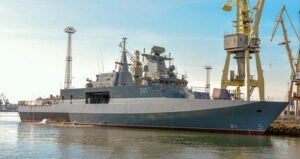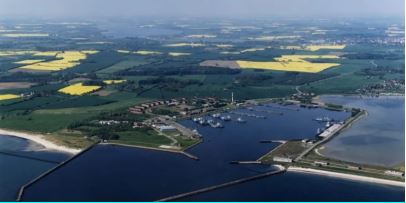Poland's new naval strategy
A maritime strategy is a comprehensive orientation of all aspects of national power to achieve specific political objectives in a given situation through a certain degree of control at sea (John Hattendorf). National naval strategies provide important guidance for the concrete planning of naval procurement. At the same time, published naval strategies are important instruments of deterrence, as they inform friend and foe of the intentions involved.

Polish naval battle flag with the gold-crowned white eagle. (Picture: Polish Navy)
During the Cold War, the Baltic Sea could be seen as an important battleground in a future confrontation between NATO and the Warsaw Pact. Since the 1990s, the Baltic NATO members and their partners have regarded the Baltic Sea as a peaceful environment. The Marines around the Baltic Sea reduced their capacities for access to areas (A2/AD) and focussed more on supporting missions outside this area, e.g. in the Mediterranean or the Horn of Africa. The annexation of Crimea in 2014 and the subsequent war waged by Russia in eastern Ukraine had a sobering effect on the military planning of the Baltic states. Marines from. Neither NATO nor its partner countries currently have Marinescapable of convincingly countering any Russian aggression in the Baltic Sea. However, the strength of today's Russian Marine not comparable with that of its predecessor. A convincing response must therefore also differ from the strategies of the Cold War.
In September 2014, NATO developed the so-called "Readiness Action Plan" (RAP) to reassure its eastern members. Strangely, this did not lead to a comprehensive rethink about the impact Russia's new strategy could have on the Baltic Sea region. NATO has generally responded to the new challenges with its Alliance Maritime Strategy. This called for increased Alliance transformation efforts and further planning to develop the Alliance's capabilities and identify other areas where transformation is needed. This meant that NATO members and partners would need to develop their own naval strategies, which should be in line with the Alliance strategy.

Post of honour of the Polish Navy. (Image: Polish Navy)
Poland is now the first Baltic Sea country to adopt a comprehensive naval strategy entitled "Strategiczna Koncepcja Bezpieczeństwa Morskiego Rzeczypospolitej Polskiej" (Polish Strategic Concept for Maritime Security). The paper was developed by a committee of experts consisting of members of the National Security Office, the Polish Naval Academy, the Shipbuilding Council and the General Józef Haller Institute. The committee avoided to summarise its findings "Polish naval strategy". Instead, the contribution is more of a first step that would lead to a more comprehensive strategy.
"The current armed forces of the Polish navy are not sufficient"
As ambitious as the new Polish naval strategy may be, it must reflect the current state of the Polish navy which largely operates with obsolete platforms. This includes five submarines (one Soviet KILO and four former Norwegian NATO units from the Cold War). The picture is not much rosier when you look at the surface units: Two frigates and a corvette, each built in the 1980s. Support and combat support ships are equally outdated.
The authors of the naval strategy are aware of the inadequacies of the current equipment. Their assessment is a clear wake-up call for the Polish navy. It states: "The current armed forces of the Polish navy are inadequate for the threats, challenges and opportunities arising from the country's maritime security environment, its objectives and maritime theatre of operations. The response to the major threats posed by Russia in the Baltic Sea region would not be possible with the current potential and forces required under the agreed naval modernisation programme."

Minesweeper of the KORMORAN 2 class. (Picture: Michael Nitz)
The authors have recognised these shortcomings and have now formulated the most comprehensive strategy possible, which could form the basis for future naval planning. The strategy addresses the current threats and risks to the sea and lists a whole range of dynamically changing threats, such as disregard for international maritime law, terrorism, piracy, cross-border crime, cyber warfare, militarisation of the Baltic Sea region, the Russian energy monopoly, water pollution and climate change. For the Polish navy these threats would pose major challenges, such as developing their potential to ensure an acceptable level of maritime security and ensuring co-operation with NATO and the EU. To achieve this, the strategy calls for the adaptation of the Marine to the current challenges and threats in connection with the Polish maritime security. This could only be achieved by reorganising the political and military use of the Polish navy The EU and NATO could be achieved by transforming the current model, which dates back to the Warsaw Pact era, into a current naval model that is integrated into the allied structures.
The strategy recognises a lack of maritime culture in Poland, a de facto maritime blindness, which is one of the biggest problems of the Polish naval forces in general and the Polish navy in particular. The need for the existence and creative use of present and future resources would therefore not be expressed in a way that is limited to the Polish society.
The authors are in favour of Poland's continued participation in operations outside NATO and the EU in order to secure common strategic maritime security interests outside European waters in areas that are vital to Poland's national interests. The areas of vital interest are defined much more broadly than in a narrow approach, which would only include territorial waters and neighbouring areas. The Baltic Sea and the Danish Straits, the North Sea, the Norwegian Sea, the Mediterranean Sea with all neighbouring Atlantic areas as well as the Black Sea and the waters of the Arctic are named as the "closest areas of vital importance to Poland".
Poland must acquire capabilities in several areas in order to achieve the goal of being able to act both in the national interest and as an active participant in alliances and coalitions. The strategy calls for coastal defence capabilities and at the same time those capabilities that would enable cooperation in protecting the sovereignty of the allies. The Polish Naval forces should be enabled to participate permanently in joint operations (e.g. NATO Maritime Groups). To this end, Poland needs warships with standardised tactical and technical capabilities that enable flexible cooperation in task forces. To this end, all areas of operational capabilities (command and control, reconnaissance, firepower, force projection and survivability, action support, movement and manoeuvres as well as non-military support) must be developed.

The Polish modernisation programme also includes six Coastal Defence Vessels. (Graphic: Rolls Royce)
The Polish strategy was developed against the backdrop of the aforementioned change in the character of the Baltic Sea region. It therefore contains a scenario of how a potential conflict with Russia could develop. It is expected that any violent conflict would involve naval, air and land forces. An escalating conflict would then have the potential of a high-intensity (albeit short-lived) conflict in the Baltic Sea region. Russian Baltic Sea ports could easily be closed by NATO forces, with possible co-operation from the Swedish or Finnish military. Here the Polish navyair forces and mobile coastal batteries capable of destroying enemy warships would play an important role. This would require not only the development of area denial capability, but also local sea control.
Procurement proposals
To optimise the Polish To enable armed forces to neutralise Russian A2/AD assets, they must gain local sea control in the four domains of air, surface, submarine and cyberspace. The likelihood of a high-level conflict in the Baltic Sea region requires the development of maritime platforms that can neutralise the remaining weapons systems of the Polish navy (in particular the Coastal Missile Battery, CMB) and air force components.
The previous Polish The "Fighting the Threats at Sea 2013-2022/30" operational programme is rejected by the strategy authors because it would have merely replaced old Warsaw Pact platforms with newer ones of the corresponding classes, which would have led to the preservation of the pre-modern navy concept. Modern concepts of maritime security and national defence as well as NATO standards would have been disregarded.

After the launch of the "Slazak" in 2015, the GAWRON class programme was stopped. (Image: Polish Navy)
The current modernisation programme for the Polish navywhich includes the acquisition of warships of the MIECZNIK and CZAPLA classes, would not be sufficient, as these are only to be equipped with a self-defence system (short-range), if at all. The only units of the Polish navyThe most advanced air defence capabilities are the OLIVIER-HAZARD-PERRY class frigates, which are equipped with SM-1 (Standard Missile) systems with a range of 40 km. Therefore, the urgent need to introduce the next generation of multi-role frigates with advanced air defence capabilities is emphasised. This would not only close the existing capability gap, but also facilitate the deployment of other units of the Polish navy in co-operation with the air force.
An important point for the Polish Naval planners believe that corvettes would not only be the most unsuitable because of their limited seaworthiness compared to frigates and their inability to defend against coordinated missile attacks from several directions. Only frigates could provide effective air defence to other ships, CMBs and land forces.
The strategists propose the development of a so-called post-modern, medium global "Force Projection Navy" of category 3. This is a rather ambitious proposal, as the Polish navy can currently be regarded primarily as a supporting force with the aim of protecting territory.
The development of Poland's credibility as an ally should be achieved through regular participation in the activities of the standing maritime task forces and alliance operations and at the same time demonstrate to any aggressors the Alliance's willingness and ability to respond (Article 5).
For the concrete modernisation of the Polish For naval forces, the strategy recommends the procurement of multi-purpose combat ships (frigates), submarines (with capabilities to combat surface and underwater units and mines, to conduct reconnaissance and control missions, to deploy special forces and to launch tactical land attack missiles), reconnaissance and patrol aircraft, helicopters (for anti-submarine warfare), mine hunters and mine countermeasures ships, as well as unmanned systems to support air, sea and underwater operations.
The strategy does not specify numbers for specific platforms. However, it is recommended that the 1:3 operating coefficient (the ability of one in three ships of a certain class to perform certain tasks at all times) be adhered to. Once the modernisation programme has been successfully implemented, only regular and alternating participation can be expected. Polish warships in NATO operations the acquisition of a cadre of the Polish navy with practical skills and useful experience.
"Poland's Strategic Concept for Maritime Security" represents an important step towards a planned and carefully structured modernisation of maritime security. Polish naval forces. Its further development and implementation would enable the country to revitalise its maritime importance and meet the new challenges in the Baltic Sea region and beyond.
Author: Jan Asmussen is a professor at the Faculty of Command and Naval Operations of the Polish Naval Academy in Gdynia.












0 Kommentare